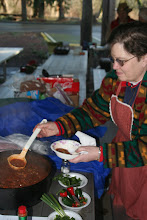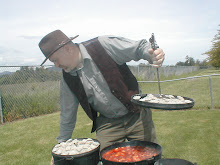By John Roberts – all rights reserved
The Dutch oven, a basic, simple cast iron cooking pot has a rich and storied history. With roots reaching back to the 7th century, this simple pot has proved its mettle from its first mention in history until today. Imagine tuning into one of those home shopping TV programs and hearing someone tell you about a cooking device that could bake, broil, steam, boil, fry, braise, and stew. As an additional benefit it is non-stick, easy to clean, and could be used on a stove, in an oven, in a fireplace or over a camp fire. It is solidly constructed and designed to last for generations. Why not buy two?
Highlights of Dutch oven history include: being included in the list of Crown Jewels of King Edward III of England; undergoing a simple design change by an inventive silversmith which is still used today; being listed as one of only three items that Lewis and Clark said they would never trade or leave behind while on their expedition west (the others were their rifles and scientific instruments); one of the most sought after pieces of equipment for mountain men and trappers; and named as the official cooking pot of the State of Utah.
The versatility of the Dutch oven means that only one pot is necessary. With the early settlers who migrated west this proved to be a huge advantage as this left room for other belongings and valuable provisions. The Dutch oven also could be used with a variety of heat sources. Wood was always preferred, but when wood was not available dried “meadow muffins” or “buffalo chips” worked well.
Today there are two distinct classifications of Dutch ovens. One is the classic style, a flat bottomed model with a domed lid. These are available in the basic black unfinished style or the designer models which are enameled in bright colors for today’s modern kitchens. The other class is known as the Camp Dutch Oven. This is the model most familiar. With its three legged design and the lid with a lip to hold the hot coals this model is the ideal design for camping and outdoor cooking. Whether you cook only in your kitchen or love to cook outdoors the Dutch oven is a “must have” for your cooking and dining enjoyment.
We hope to continue the Dutch oven discussion in the near future by providing vignettes of interesting historical facts and also some fun recipes which can be used on your next campout or social event.
Friday, May 29, 2009
Wednesday, May 27, 2009
Crunch Nut Sweet Potatoes
2 Cups mashed sweet potatoes
1 ¼ cup Sugar
2 eggs
¾ stick of butter
½ cup milk
½ tsp nutmeg
½ tsp cinniman
Mix and bake at 400 degrees for 20 minutes
Topping:
¾ cup Corn Flakes crushed
½ cup walnuts
½ cup Brown Sugar
¾ stick butter
Mix and spread over potatoes and bake for 10 minutes.
1 ¼ cup Sugar
2 eggs
¾ stick of butter
½ cup milk
½ tsp nutmeg
½ tsp cinniman
Mix and bake at 400 degrees for 20 minutes
Topping:
¾ cup Corn Flakes crushed
½ cup walnuts
½ cup Brown Sugar
¾ stick butter
Mix and spread over potatoes and bake for 10 minutes.
Subscribe to:
Comments (Atom)



